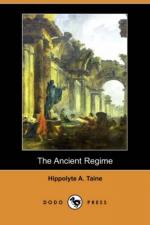The first is scientific discovery, admirable on all sides, and beneficent in its nature; it is made up of masses of facts slowly accumulated and then summarily presented, or in rapid succession. For the first time in history the sciences expand and affirm each other to the extent of providing, not, as formerly, under Galileo and Descartes, constructive fragments, or provisional scaffolding, but a definite and demonstrated system of the universe, that of Newton.[1] Around this capital fact, almost all the discoveries of the century, either as complementary or as prolongations, range themselves. In pure mathematics we have the Infinitesimal Calculus discovered simultaneously by Leibnitz and Newton, mechanics reduced by d’Alembert to a single theorem, and that superb collection of theories which, elaborated by the Bernouillis, Euler, Clairaut, d’Alembert, Taylor and Maclaurin, is finally completed at the end of the century by Monge, Lagrange, and Laplace.[2] In astronomy, the series of calculations and observations which, from Newton to Laplace, transforms science into a problem of mechanics, explains and predicts the movements of the planets and of their satellites, indicating the origin and formation of our solar system, and, extending beyond this, through the discoveries of Herschel, affording an insight into the distribution of the stellar archipelagos, and of the grand outlines of celestial architecture. In physics, the decomposition of light and the principles of optics discovered by Newton, the velocity of sound, the form of its undulations, and from Sauveur to Chladni, from Newton to Bernouilli and Lagrange, the experimental laws and leading theorems of Acoustics, the primary laws of the radiation of heat by Newton, Kraft and Lambert, the theory of latent heat by Black, the proportions of caloric by Lavoisier and Laplace, the first true conceptions of the source of fire and heat, the experiments, laws, and means by which Dufay, Nollet, Franklin, and especially Coulomb explain, manipulate and, for the first time, utilize electricity. — In Chemistry, all the foundations of the science: isolated oxygen, nitrogen and hydrogen, the composition of water, the theory of combustion, chemical nomenclature, quantitative analysis, the indestructibility of matter, in short, the discoveries of Scheele, Priestley, Cavendish and Stahl, crowned with the clear and concise theory of Lavoisier. — In Mineralogy, the goniometer, the constancy of angles and the primary laws of derivation by Romé de Lisle, and next the discovery of types and the mathematical deduction of secondary forms by Haüy. — In Geology, the verification and results of Newton’s theory, the exact form of the earth, the depression of the poles, the expansion of the equator,[3] the cause and the law of the tides, the primitive fluidity of the planet, the constancy of its internal heat, and then, with Buffon, Desmarets, Hutton and Werner, the aqueous or igneous origin of rocks, the stratifications of the earth, the structure




